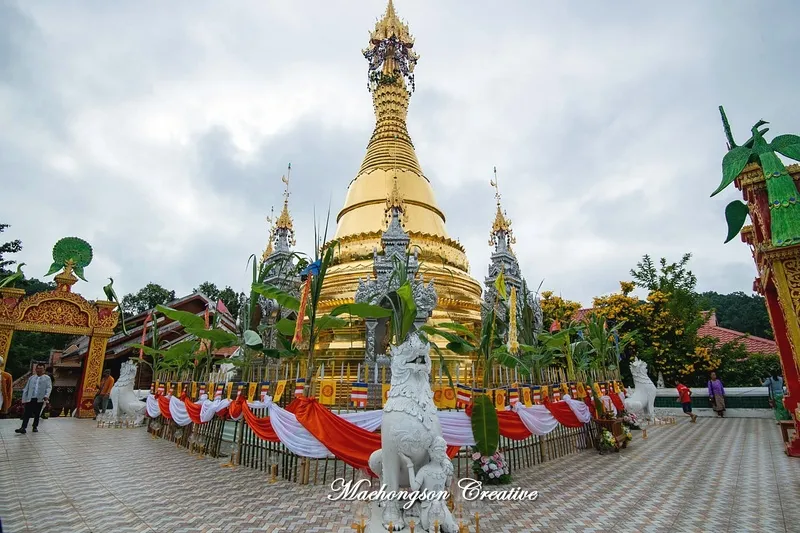Wat Pang Mu

Rating: 4.4/5 (5 votes)
Mae Hong Son attractions
Attractions in Thailand
Operating day: Daily
Operating time: 08.00 - 17.00
Wat Pang Mu Attractions in Mae Hong Son Pang Mu, Muang Mae Hong Son, Mae Hong Son. Wat Pang Mu is affiliated with the Maha Nikaya sect and occupies an area of 5 rai and 52 square wah. Its boundaries are as follows: to the north, it adjoins a public road; to the east, it borders the Mae Hong Son-Pai Road; to the south, it is adjacent to another public road; and to the west, it adjoins the City Shrine. The temple was established in 1967 and received the official boundary marker (Vissungkamsima) on August 26, 1957.
The general environment of Wat Pang Mu is characterized by its entrance gate, which is built in the Tai Yai architectural style. The entrance features two posts, each shaped like a long drum. The upper part of the posts is sculpted to show two Tai Yai men dressed in traditional attire, carrying large gongs, and posing as if they are playing the gongs. On the sides of the posts, there are figures of a Tai Yai woman performing a dance and a Tai Yai man playing a cymbal. In front of the entrance posts, two square columns stand. One column is sculpted to depict a Tai Yai man, and the other features a Tai Yai woman holding a flower offering.
Inside the temple, there is an ancient stupa that has been in place for many years, followed by an old ordination hall built in 1957. This ordination hall is the oldest in the temple and remains in its original condition. Upon reaching the upper part of the temple, visitors can see the main Buddha image, which is a beautiful and ancient Tai Yai-style Buddha.
One of the unique features of Wat Pang Mu is a column unlike those in other temples. It is shaped like a long drum and reaches up to the ceiling of the temple, making it potentially the only one of its kind in the world. The temple also teaches moral principles, with Dharma verses written on the ceiling to remind visitors who come to make merit. Wat Pang Mu is an ancient temple that preserves much of Tai Yai culture. It is a place for studying both Dharma and the way of life of the Tai Yai people.
The temple has built traditional Tai Yai houses for people to learn about the lifestyle of the Tai Yai people from the past. Currently, the temple is home to four monks, four novices, and one lay devotee. The temple complex includes six other salas (meeting halls), fifteen restrooms, one traditional Tai house, one news tower, two kitchens, one Vissungkamsima hall, and three stupas (two in the temple grounds and one on the hill).
Comment
| Keyword (Advance) |
 Facebook Fanpage
Facebook Fanpage

 Category:
Category:  Group:
Group:  Art, Culture and Heritage
Art, Culture and Heritage Historical Sites and Monuments(
Historical Sites and Monuments( Landmarks and Memorials(
Landmarks and Memorials( Art, Craft Centres, Tradition(
Art, Craft Centres, Tradition( Museums(
Museums( Educational Places
Educational Places Educational Gardens, Farm(
Educational Gardens, Farm( Other religious and spiritural sites(
Other religious and spiritural sites( Research and Development
Research and Development Royal Project(
Royal Project( Suburban Living
Suburban Living Village, Community(
Village, Community( Local Market(
Local Market( Nature and Wildlife
Nature and Wildlife National Parks and Marine Reserves(
National Parks and Marine Reserves( Mountain (Doi)(
Mountain (Doi)( Dam, Reservoir, Lake(
Dam, Reservoir, Lake( Waterfalls(
Waterfalls( Hot Springs(
Hot Springs( Caves(
Caves( Flower Field(
Flower Field( River, Canal(
River, Canal( Other natural attractions(
Other natural attractions( Entertainment and Agricultural
Entertainment and Agricultural Farm, Parks, Gardens and Ecotourism(
Farm, Parks, Gardens and Ecotourism( Shopping
Shopping Shopping and Night Market(
Shopping and Night Market( Travel Articles, Recipes
Travel Articles, Recipes Travel Review, Food Review(
Travel Review, Food Review(